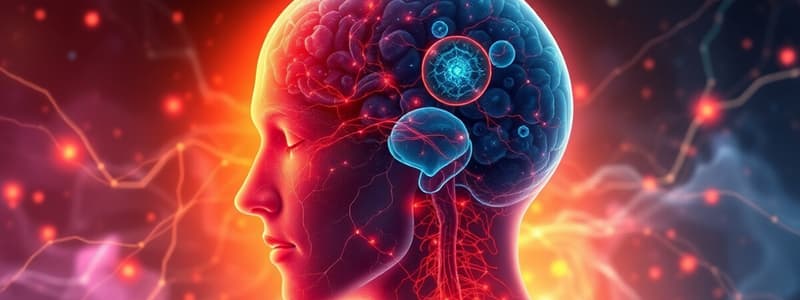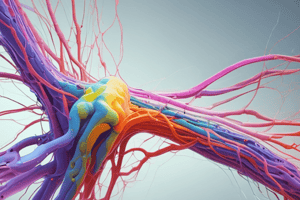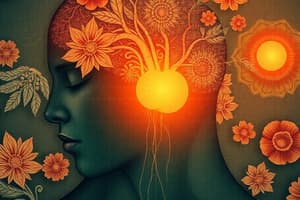Podcast
Questions and Answers
Which of the following is NOT a deep cerebellar nucleus?
Which of the following is NOT a deep cerebellar nucleus?
- Caudate (correct)
- Dentate
- Embolliform
- Globose
What is the name of the functional subdivision of the cerebellum that functions in error correction and receives input from the spinal cord?
What is the name of the functional subdivision of the cerebellum that functions in error correction and receives input from the spinal cord?
- Cerebrocerebellum
- Flocculonodular lobe
- Spinocerebellum (correct)
- Vestibulocerebellum
What is the name of the most lateral deep cerebellar nucleus?
What is the name of the most lateral deep cerebellar nucleus?
- Embolliform
- Fastigial
- Globose
- Dentate (correct)
Which of the following is a consequence of damage to the flocculonodular lobe?
Which of the following is a consequence of damage to the flocculonodular lobe?
Which of the following is TRUE about the cerebellar hemispheres?
Which of the following is TRUE about the cerebellar hemispheres?
Which of the following is the primary function of the cerebrocerebellum?
Which of the following is the primary function of the cerebrocerebellum?
Which of the following arteries supplies blood to the cerebellum?
Which of the following arteries supplies blood to the cerebellum?
What is the primary output of the cerebellum?
What is the primary output of the cerebellum?
Which mechanoreceptor is best suited for detecting static touch and is slow-adapting?
Which mechanoreceptor is best suited for detecting static touch and is slow-adapting?
Which of the following accurately describes the function of a Pacinian corpuscle?
Which of the following accurately describes the function of a Pacinian corpuscle?
A patient reports a constant sensation of skin stretching. Which receptor type is most likely responsible for this sensation?
A patient reports a constant sensation of skin stretching. Which receptor type is most likely responsible for this sensation?
What does the acronym 'MILD' represent in the context of sensory receptors?
What does the acronym 'MILD' represent in the context of sensory receptors?
Which of the following is characterized by a weird tingling or numb sensation on the skin?
Which of the following is characterized by a weird tingling or numb sensation on the skin?
Which pathway is primarily responsible for conveying fine touch and vibration information to the brain?
Which pathway is primarily responsible for conveying fine touch and vibration information to the brain?
Where do second order neurons in the dorsal column medial lemniscus (DCML) pathway synapse?
Where do second order neurons in the dorsal column medial lemniscus (DCML) pathway synapse?
Which of the following best describes the role of transient receptor potential (TRP) channels in the somatosensory system?
Which of the following best describes the role of transient receptor potential (TRP) channels in the somatosensory system?
Which of the following best describes the function of the thalamus within the nervous system?
Which of the following best describes the function of the thalamus within the nervous system?
What is the primary role of oligodendrocytes within the nervous system?
What is the primary role of oligodendrocytes within the nervous system?
Disruptions of which two resources may lead to neuronal cell death?
Disruptions of which two resources may lead to neuronal cell death?
Which of the following is the most accurate description for how sensory transduction occurs?
Which of the following is the most accurate description for how sensory transduction occurs?
What role do microglial cells play in the nervous system?
What role do microglial cells play in the nervous system?
Which type of mechanoreceptor is characterized by being rapidly adapting and found near the epidermis?
Which type of mechanoreceptor is characterized by being rapidly adapting and found near the epidermis?
Which of the following is NOT part of the brainstem?
Which of the following is NOT part of the brainstem?
Which of the following is NOT primarily associated with somatosensation pathways?
Which of the following is NOT primarily associated with somatosensation pathways?
Which receptor is responsible for detecting noxious heat above 125 F?
Which receptor is responsible for detecting noxious heat above 125 F?
What type of pain results from injury to the peripheral nervous system (PNS) or central nervous system (CNS)?
What type of pain results from injury to the peripheral nervous system (PNS) or central nervous system (CNS)?
Which pathway carries information about pain, temperature, and crude touch from the body?
Which pathway carries information about pain, temperature, and crude touch from the body?
Which brain structure is key for endogenous pain inhibition and sympathetic responses?
Which brain structure is key for endogenous pain inhibition and sympathetic responses?
What kind of sensory information does the Trigeminothalamic Tract carry?
What kind of sensory information does the Trigeminothalamic Tract carry?
Which part of the brain is involved in emotional learning related to pain?
Which part of the brain is involved in emotional learning related to pain?
What type of pain is described as normal physiological response to noxious stimuli?
What type of pain is described as normal physiological response to noxious stimuli?
Where do second-order neuron axons in the ALS pathway terminate?
Where do second-order neuron axons in the ALS pathway terminate?
What role does the globus pallidus internal segment (GPi) play in movement regulation?
What role does the globus pallidus internal segment (GPi) play in movement regulation?
Which structure releases dopamine to facilitate movement in the basal ganglia?
Which structure releases dopamine to facilitate movement in the basal ganglia?
What is a key characteristic of Parkinson's disease in terms of movement?
What is a key characteristic of Parkinson's disease in terms of movement?
What is the function of the indirect pathway in the basal ganglia?
What is the function of the indirect pathway in the basal ganglia?
Which disease is characterized by the degeneration of neurons in the striatum, leading to uncontrolled movements?
Which disease is characterized by the degeneration of neurons in the striatum, leading to uncontrolled movements?
What symptom is typically associated with Parkinson's disease?
What symptom is typically associated with Parkinson's disease?
Which neurotransmitter is primarily used by the neurons in the substantia nigra?
Which neurotransmitter is primarily used by the neurons in the substantia nigra?
What mnemonic helps remember the characteristic of slow movements in Parkinson's disease?
What mnemonic helps remember the characteristic of slow movements in Parkinson's disease?
What is the primary factor affecting the speed of diffusion over long distances?
What is the primary factor affecting the speed of diffusion over long distances?
How do ions primarily move across the cell membrane?
How do ions primarily move across the cell membrane?
What primarily drives the flow of water in osmosis?
What primarily drives the flow of water in osmosis?
What distinguishes osmotic pressure from osmolarity?
What distinguishes osmotic pressure from osmolarity?
What role does the Na+/K+ pump play in cellular function?
What role does the Na+/K+ pump play in cellular function?
Which characteristic accurately defines tonicity?
Which characteristic accurately defines tonicity?
How does the reflection coefficient affect solute particles' passage through a membrane?
How does the reflection coefficient affect solute particles' passage through a membrane?
What is the significance of Van't Hoff's equation in relation to osmotic pressure?
What is the significance of Van't Hoff's equation in relation to osmotic pressure?
Flashcards
What are the two main components of the nervous system?
What are the two main components of the nervous system?
The nervous system is composed of two main parts: the central nervous system (CNS) which includes the brain and spinal cord, and the peripheral nervous system (PNS), which encompasses the nerves extending from the CNS to the rest of the body.
What are the critical requirements for the nervous system to function properly?
What are the critical requirements for the nervous system to function properly?
The nervous system relies heavily on energy, primarily utilizing glucose and oxygen. Disruptions in its supply of these vital nutrients can lead to severe damage or even death of nerve cells.
What is the role of ascending pathways in the nervous system?
What is the role of ascending pathways in the nervous system?
Ascending pathways are responsible for transmitting sensory information from the periphery (your body) to the central nervous system (brain).
What do descending pathways do in the nervous system?
What do descending pathways do in the nervous system?
Signup and view all the flashcards
What is the brainstem and what components does it include?
What is the brainstem and what components does it include?
Signup and view all the flashcards
What is the cerebellum and what function does it serve?
What is the cerebellum and what function does it serve?
Signup and view all the flashcards
What is the role of the thalamus?
What is the role of the thalamus?
Signup and view all the flashcards
What is the function of the basal ganglia?
What is the function of the basal ganglia?
Signup and view all the flashcards
Pacinian corpuscle
Pacinian corpuscle
Signup and view all the flashcards
Merkel cell neurite complex
Merkel cell neurite complex
Signup and view all the flashcards
Ruffini corpuscle
Ruffini corpuscle
Signup and view all the flashcards
Dorsal Column-Medial Lemniscus (DCML) pathway
Dorsal Column-Medial Lemniscus (DCML) pathway
Signup and view all the flashcards
Anterolateral System (ALS) / Spinothalamic pathway
Anterolateral System (ALS) / Spinothalamic pathway
Signup and view all the flashcards
Nociceptors
Nociceptors
Signup and view all the flashcards
Thermal Receptors
Thermal Receptors
Signup and view all the flashcards
TRPV1 (Transient Receptor Potential Vanilloid 1)
TRPV1 (Transient Receptor Potential Vanilloid 1)
Signup and view all the flashcards
TRPV2 Receptor
TRPV2 Receptor
Signup and view all the flashcards
TRPV1 Receptor
TRPV1 Receptor
Signup and view all the flashcards
TRPA1 Receptor
TRPA1 Receptor
Signup and view all the flashcards
Nociceptive Pain
Nociceptive Pain
Signup and view all the flashcards
Neuropathic Pain
Neuropathic Pain
Signup and view all the flashcards
Spinothalamic Tract (STT)
Spinothalamic Tract (STT)
Signup and view all the flashcards
Pain Matrix
Pain Matrix
Signup and view all the flashcards
Diffusion
Diffusion
Signup and view all the flashcards
Osmosis
Osmosis
Signup and view all the flashcards
Osmotic pressure
Osmotic pressure
Signup and view all the flashcards
Osmolarity
Osmolarity
Signup and view all the flashcards
Tonicity
Tonicity
Signup and view all the flashcards
Aquaporin
Aquaporin
Signup and view all the flashcards
Osmotic pressure difference
Osmotic pressure difference
Signup and view all the flashcards
Reflection coefficient
Reflection coefficient
Signup and view all the flashcards
What is the cerebellum?
What is the cerebellum?
Signup and view all the flashcards
What are the lobes of the cerebellum?
What are the lobes of the cerebellum?
Signup and view all the flashcards
What happens when the cerebellum is damaged?
What happens when the cerebellum is damaged?
Signup and view all the flashcards
What is the cerebellum's role in motor control?
What is the cerebellum's role in motor control?
Signup and view all the flashcards
What does the spinocerebellum do?
What does the spinocerebellum do?
Signup and view all the flashcards
What does the vestibulocerebellum do?
What does the vestibulocerebellum do?
Signup and view all the flashcards
What does the cerebrocerebellum do?
What does the cerebrocerebellum do?
Signup and view all the flashcards
How does the cerebellum communicate with other parts of the brain?
How does the cerebellum communicate with other parts of the brain?
Signup and view all the flashcards
What is the role of the Globus Pallidus (GPi) in movement?
What is the role of the Globus Pallidus (GPi) in movement?
Signup and view all the flashcards
What is the direct pathway of the basal ganglia responsible for?
What is the direct pathway of the basal ganglia responsible for?
Signup and view all the flashcards
What is the indirect pathway of the basal ganglia responsible for?
What is the indirect pathway of the basal ganglia responsible for?
Signup and view all the flashcards
What is the cause of Parkinson's disease?
What is the cause of Parkinson's disease?
Signup and view all the flashcards
What is the cause of Huntington's disease?
What is the cause of Huntington's disease?
Signup and view all the flashcards
What is the function of the substantia nigra?
What is the function of the substantia nigra?
Signup and view all the flashcards
What is the role of D1 dopamine receptors?
What is the role of D1 dopamine receptors?
Signup and view all the flashcards
What is the function of the subthalamic nucleus (STN)?
What is the function of the subthalamic nucleus (STN)?
Signup and view all the flashcards
Study Notes
Nervous System and Pain - Week 1
- The nervous system is composed of the central nervous system (CNS) and peripheral nervous system (PNS).
- High energy demands of the nervous system require glucose and blood flow. Disruption of these can cause neuron death.
- Ascending pathways carry sensory information from the periphery to the CNS.
- Descending pathways carry information from the CNS to the periphery.
- The brainstem includes the midbrain, pons, and medulla.
- The cerebellum coordinates movement.
- Basal ganglia help regulate movement.
- The thalamus acts as a relay station for body senses.
- The hippocampus is involved in memory.
- The amygdala plays a role in emotions, fear, fighting, food, and mating behaviors.
- Neurons are the smallest unit of the nervous system.
- Calcium is needed for synaptic function.
- Glial cells support neurons. These include oligodendrocytes, astrocytes, and microglia.
- Astrocytes form the blood-brain barrier and synthesize neurotransmitters.
- Glioblastomas are a highly malignant type of primary brain cancer.
- Oligodendrocytes produce myelin in the CNS.
- Schwann cells produce myelin in the PNS.
- Spinal reflexes exhibit neural circuits like feedforward excitation, feedforward inhibition, and convergence.
- Microglial cells remove debris after neuronal injury.
Nervous System and Pain - Week 2
- Sensory transduction couples stimulus detection to ion channel opening/closing.
- Sensory neurons generate membrane potentials in response to stimuli.
- Somatosensation provides information about internal and external body conditions.
- Somatosensation includes touch and position pathways (mechanoreceptors) and pain and temperature pathways (thermoreceptors, chemoreceptors).
Nervous System and Pain - Week 3
- Facial nerves control facial muscle movements and provide sensory information from the anterior two-thirds of the tongue.
- Facial nerves emerge from the pons in the brain stem and follow a complex path to reach their destinations in the face.
- Upper motor neuron lesions cause issues with the lower facial muscles, while lower motor neuron lesions affect muscles on the same side of the face.
Nervous System and Pain - General
- TRPV1 receptors are activated by heat and capsaicin.
- TRPV2 receptors are activated by extreme heat.
- TRPA1 receptors are activated by noxious cold temperatures.
- Nociceptive pain is the body's normal response to noxious stimuli.
- Neuropathic pain results from nerve damage.
- The periaqueductal gray (PAG) plays a role in pain modulation and relief.
- Basal ganglia are involved in initiating and regulating movements.
- The cerebellum helps coordinate complex movements.
- The globus pallidus, an output nucleus of the basal ganglia, inhibits the thalamus in a resting state.
- The indirect pathway in the basal ganglia helps suppress unwanted movements.
- The direct pathway allows for the execution of desired movements.
- The spinalthalamocortical tract relays sensory information related to pain and temperature.
- The trigeminothalamic pathway carries similar sensory information for the face.
- The cerebellum helps with coordination and balance.
Cell Membranes and Transport
- Cell membranes are selectively permeable.
- Hydrophobic substances can pass through the membrane directly.
- Hydrophilic substances require channels or pores.
- The fluid mosaic model describes membrane structure.
- Cell membranes maintain concentration differences of solutes.
- Cholesterol helps stabilize the membrane.
- Phospholipids have hydrophilic heads and hydrophobic tails.
- Channels and pores are proteins that facilitate transport.
- Diffusion is the movement of substances from high to low concentration.
Osmosis
- Osmosis is the movement of water across a semipermeable membrane from a region of lower solute concentration to a region of higher solute concentration.
- Cell volume changes depending on the tonicity of the solution.
- Hypertonic solutions cause cells to shrink.
- Hypotonic solutions cause cells to swell.
- Isotonic solutions maintain cell volume.
Studying That Suits You
Use AI to generate personalized quizzes and flashcards to suit your learning preferences.



